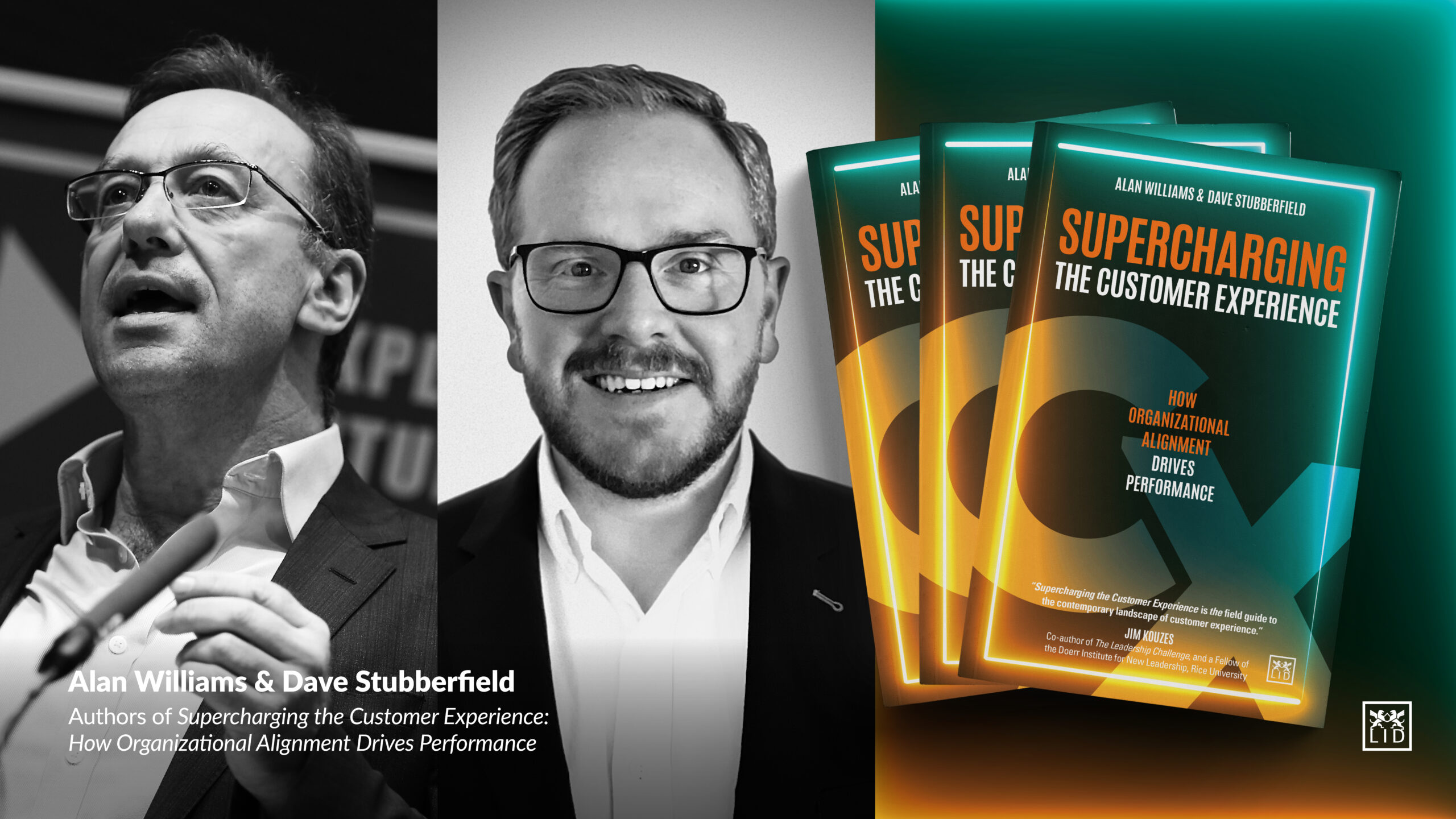|
The Five Elements of an Effective Customer Experience Strategy with Alan Williams & Dave Stubebrfield
The Five Elements of an Effective Customer Experience Strategy

By Guest Contributors Alan Williams & Dave Stubberfield
Authors of Supercharging the Customer Experience, Alan Williams and Dave Stubberfield, reveal the five elements of an effective customer experience strategy that drives performance.
Today, we live in the age of the customer, where customer expectations are higher than ever, and they have more choices than ever before. Customers are also making decisions and choices on a different basis than before. For many customers, the previous rational approach has been replaced by choices based on what is important to them and their values. Values alignment between organizations and customers is becoming increasingly important
Companies that excel in CX not only satisfy their customers but also cultivate loyalty and advocacy, driving growth and profitability. Sounds easy, right? So why is a great customer experience still so rare?
Designing and implementing a comprehensive CX strategy involves multiple components, each playing a critical interconnected role. Our approach is fresh and different, comprising of five Elements:
- Brand Identity
- Employee Engagement
- Customer Experience
- Systems & Processes
- Measurement & Insight
In this article, we explore these five Elements, and identify key considerations and common pitfalls to avoid when developing or enhancing your organization’s CX strategy.
Brand Identity
Your brand identity is the foundation of your customer experience. It encapsulates what your company stands for, its values, and its promise to customers. A strong, clear brand identity helps differentiate your business in a crowded market and sets the tone for all customer interactions. Teams or functions within an organization also have their own brand identity – how they engage or interact with other teams in the customer journey.
Ensure that your brand identity is consistently communicated across all channels and touchpoints. Consistency builds trust and recognition – both when dealing with customers directly, or with different teams across the organization. Your brand identity should reflect your company’s true values and mission. Authenticity resonates with customers and fosters genuine connections and loyalty. Customer-centricity is key – align your brand identity with the needs and expectations of your target audience. Understanding your customers’ desires and pain points allows you to position your brand effectively.
An effective Brand Identity is achieved by avoiding inconsistency and any perception of not being authentic. Mixed messages or conflicting brand imagery can confuse customers and weaken your brand’s impact. Another area to be aware of is overpromising and underdelivering – it just erodes trust. Ensure your brand promises are realistic and achievable.
Employee Engagement
Employees are the heart of any organization, and that goes for customer experience strategy too. Engaged employees who are committed to the company’s mission and values are more likely to deliver exceptional customer service and contribute positively to the overall customer experience. Empower and equip employees with the tools, knowledge, and authority to resolve customer issues and make decisions that enhance the customer experience.
Invest in continuous training and development programs to keep employees updated on best practices and emerging trends in customer service – across every role and function of the organization. Remember, it’s not just the CX team that’s responsible for the customer experience. We believe that reward and recognition (done well) delivers one of the highest returns on investment you will see – acknowledge and reward employees who exemplify excellent customer experience and are living and breathing the values and associated behaviours. Recognition helps to build a positive work environment and motivates others, which, in turn, builds buy-in and increases chances of success.
Effective Employee Engagement is achieved by avoiding the mindset that employees’ voices and feedback is not important. Employees often have valuable insights into customer pain points and areas for improvement. Ignoring their feedback can lead to missed opportunities. Also, overburdened or under-supported employees can become disengaged, leading to substandard customer interactions. This is where support and sponsorship from senior leaders plays a vital role
Customer Experience
Effective CX strategies leverage a variety of tools and techniques to understand, engage, and delight customers. Using these tools consistently can help create and design an experience that customers will be delighted with.
Key Considerations:
- Customer Journey Mapping: Visualize the end-to-end customer journey to identify touchpoints, pain points, and opportunities for improvement. Where possible, obtain feedback and data to enrich the current journey to help develop data-driven improvements.
- Persona: Create a detailed insight to a group of customers, including demographic information, behaviour patterns, values, motivations, goals and challenges to truly understand what they value from the product or service and the experience.
- Personalization: Use data and insights to deliver personalized experiences that resonate with individual customers. Personalized interactions make customers feel valued and understood.
- Omni-Channel Experience: Ensure a cohesive and consistent experience across all channels, whether online or offline. Customers should be able to transition smoothly between channels without repeating themselves. Multichannel is having different options of engagement, whereas omnichannel is consistency of delivery across all channels.
While technology is essential, it should not replace human interaction. Our over-reliance on technology, especially in growing areas such as Artificial Intelligence (AI), can do more harm than good. Consider how technology, automation and AI can support the people delivering the customer experience to achieve more personal touches and maintain a human connection.
Systems & Processes
Efficient systems and processes underpin a successful CX strategy, ensuring that all elements work seamlessly together. Streamlined operations enhance customer satisfaction by providing reliable and efficient service. Use integrated systems to manage customer data, interactions, and feedback. An integrated approach ensures that all departments have access to the same information and can work cohesively.
Consider the organization structure – is it fit for purpose? Is it set up to provide the best possible customer experience? Explore how the customer journey flow works in conjunction with the current organization structure. From there, continuously refine and optimize processes to reduce friction and improve the customer journey. Efficient processes save time for both customers and employees, increasing satisfaction for both parties.
Fragmented and disconnected systems, along with overly complex processes can lead to a silo mentality, miscommunication, and inconsistent customer experiences. It can also frustrate both employees and customers. Simplify where possible to enhance efficiency and satisfaction, both internally and externally.
Measurement & Insight
Measuring and analyzing the customer experience is crucial for continuous improvement. Without appropriate metrics and insights, it’s challenging to understand the effectiveness of your CX strategy and identify areas for enhancement. Implement robust mechanisms for collecting and analyzing customer feedback. Direct feedback provides valuable insights into customer perceptions and experiences – and remember, negative feedback is a goldmine for improvement. Addressing customer complaints and concerns can lead to significant enhancements in your CX strategy.
Establish relevant Key Performance Indicators (KPIs) to track the performance of your CX initiatives, as well as organization performance in the other Elements of our framework. Common metrics include Net Promoter Score (NPS), Customer Satisfaction (CSAT), and Customer Effort Score (CES). Crucially, the insight is the critical factor here – without the understanding of a score or rating, these KPIs can become vanity metrics. If you want to drive improvement, obtain the insight that supports the measure and harness this to improve the experience. Focus on the number drives improvement for the wrong reason – always focus on improving the experience.
Avoid being defensive about customer feedback, ensure you acknowledge it and more importantly, close the loop when an improvement has been implemented or explore for feasibility. Customers who are aware that you’ve made or even attempted improvements begin to show more loyalty.
Conclusion
An effective customer experience strategy is multi-faceted, requiring a harmonious integration of Brand Identity, Employee Engagement, Customer Experience, Systems & Processes, and Measurement & Insight. By focusing on these five Elements, organizations can create a cohesive and compelling customer experience that not only meets but exceeds customer expectations. Avoiding common pitfalls and continuously refining your strategy based on data and feedback will position your company for long-term success in the ever-evolving marketplace. Embrace this approach, and watch your customer satisfaction, loyalty, and business performance soar.
ABOUT THE AUTHORS
Suggested Reading
 There has been a general shift from a product-based economy to an experience-based one. For companies, the role of their customers and employees as ambassadors is of huge importance today. In short, the successful organization of tomorrow will deliver a customer experience that reinforces a sense of shared values with customers and stakeholders. This book defines a unique fresh approach to the design, implementation and development of customer experience strategy in any organization.
There has been a general shift from a product-based economy to an experience-based one. For companies, the role of their customers and employees as ambassadors is of huge importance today. In short, the successful organization of tomorrow will deliver a customer experience that reinforces a sense of shared values with customers and stakeholders. This book defines a unique fresh approach to the design, implementation and development of customer experience strategy in any organization.

 Alan Williams is the founder of SERVICEBRAND GLOBAL and advises business leaders internationally to deliver value-driven service. Dave Stubberfield is the director of Carter Consultancy and specializes in enabling cultural transformation to help businesses achieve greatness. Both are based in the UK.
Alan Williams is the founder of SERVICEBRAND GLOBAL and advises business leaders internationally to deliver value-driven service. Dave Stubberfield is the director of Carter Consultancy and specializes in enabling cultural transformation to help businesses achieve greatness. Both are based in the UK.